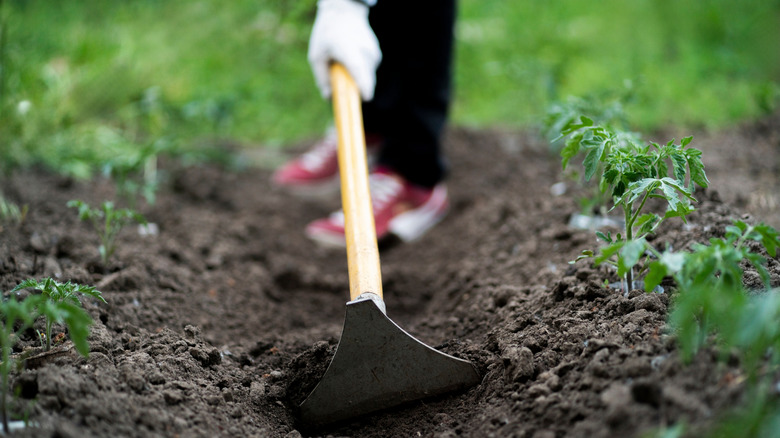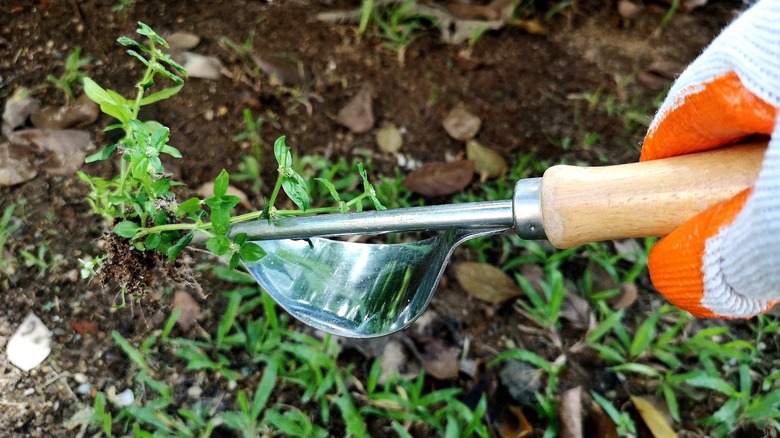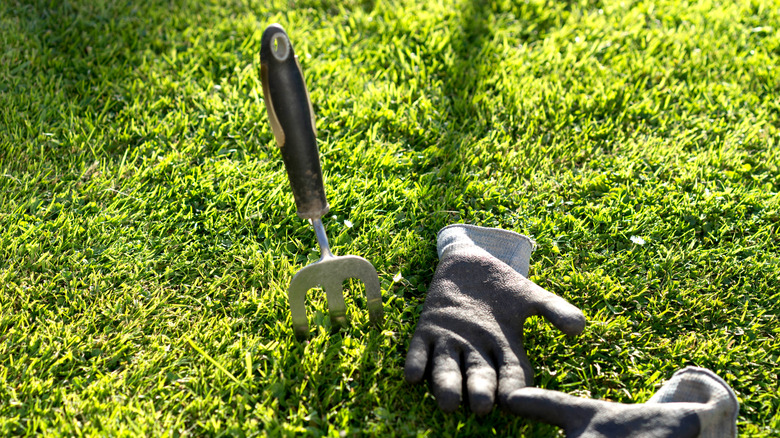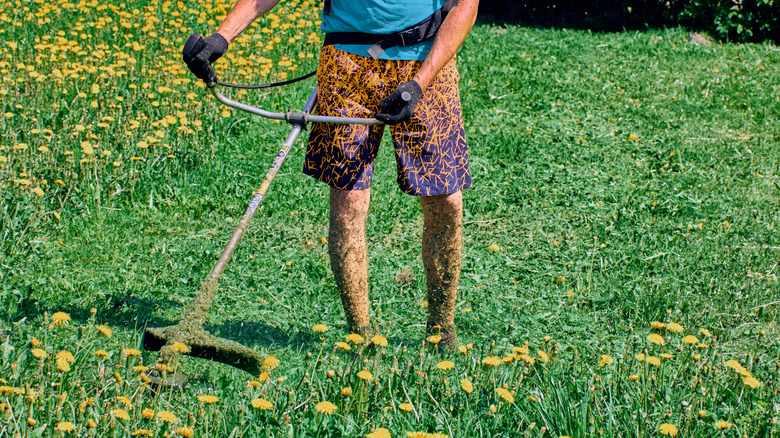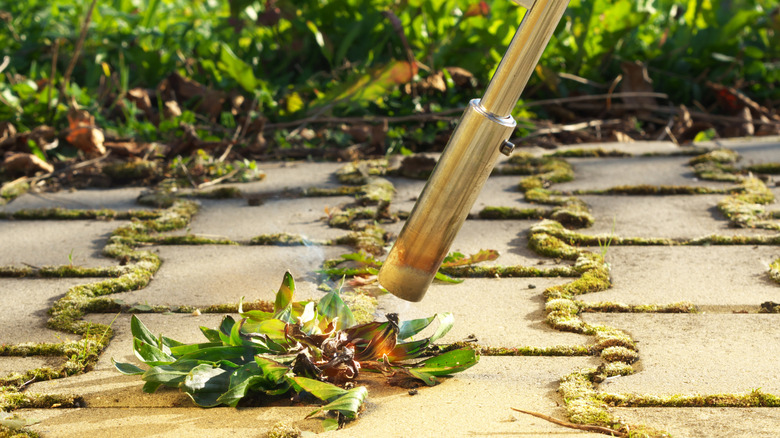The Types Of Weeder Tools You Should Use In Your Garden
We may receive a commission on purchases made from links.
So, you're minding your own business while tending to your garden, when suddenly you spot an adorable little dandelion. While the average Joe would fight temptation to "make a wish and blow," you know better. Dandelions, as beautiful as they may be, are indeed weeds; a garden's biggest foe. One blow, and those pesky puff balls will siege your entire yard. Instead, you grab your trusty hand weeder and annihilate your opponent once and for all — at least for now. When it comes to gardening, regular weeding is a must. Weeding helps prevent the spread of weed seeds and keep your plants thriving. And while you can certainly pull weeds by hand, there are plenty of weeder tools, such as garden hoes and forks, to help you get rid of weeds in your garden much quicker.
Weeder tools, like the WaLensee Weed Puller from The Home Depot for example, are designed to easily remove weeds from the root without needing to bend or kneel in the soil (speeding up the task and avoiding back strain, unlike hand weeding). Many weeder tools also have narrow blades that can carefully remove weeds without damaging the roots of your precious plants nearby. Sounds like every gardener's dream, right? Here are five types of weeder tools you should use in your garden and a deeper look at the perks of each.
Garden hoe
A garden hoe, one of the most essential gardening tools for shaping soil and weeding, has been around for thousands of years. The ancient Egyptians used wooden hoes to cultivate the soil, as well as other agricultural practices, as far back as 3,000 BCE. Today, it's traditionally designed as a long-handled tool with a flat blade or paddle on the end, but also comes in a few variations. Garden hoes are one of the most basic yet versatile tool choices for gardeners since it helps with a wide-range of tasks: leveling soil, creating furrows for planting seeds, and of course, controlling weeds.
To use a garden hoe effectively for weeding, hold it as you would a broom and push the blade into the soil slightly below the surface. Next, make a sweeping motion to slice through the weeds. Be sure to keep an upright position while using it, as garden hoes are designed to keep you from bending over. For tougher weeds, you can switch to a different style of the tool that cuts weeds further down at the root. Garden hoes are relatively inexpensive, where you can find one at a local hardware store, like the Husky L Wood Handle Garden Hoe at The Home Depot, for $20. Just keep in mind that using a hoe can still be physically demanding, especially when you have a large garden.
Hand weeder
As its name implies, a hand weeder is a small, handheld tool that makes it easier to pull weeds with more precision. Hand weeders are designed with a metal, two-tine fork end that you can use to dig out weeds, roots and all. While they may seem a bit old-fashioned, hand weeders are still a popular choice for many gardeners today, especially if you have a small garden with delicate plants. And while it might look simple to use, it isn't as easy as you may think.
To properly use a hand weeder, you need both hands: one for working the tool and the other for manually pulling the weed. Insert the pointed end of the hand weeder into the soil at an angle, near the base of the weed. Then, lever the tool to loosen and lift the roots of the weed while gently pulling on the plant. For tougher weeds, you may need to wiggle the tool back and forth to loosen the soil a bit. The Ames Steel Hand Weeder from Amazon can help get the job done for only $5. While hand weeders are great for precise weeding, they can be time-consuming for larger gardens. Also, they may not be the best choice for you if you prefer a more hands-off approach.
Garden fork
Similar to the garden hoe, a garden fork is another versatile tool. It's designed with multiple tines, similar to a pitchfork, which comes in handy for digging. It also comes in a variety of sizes, from small handheld to full-size. While the large version (also called a digging fork) is slightly heavier than others, this also makes it easy for pushing into the ground and loosening up the soil. Garden forks are a popular choice if you have stubborn weeds. The strong fork ending helps you uproot the weeds with ease.
To use a garden fork for weeding, insert the tines deep into the soil around the weed. Then, lever the fork to loosen the roots and lift or "pop" the weed out. For tough weeds, you can wiggle it back and forth to loosen the roots a little more. Garden forks are great for digging through compacted soil and maneuvering around your plants' roots to get to the pesky weeds. Just be sure to get a garden fork size that better accommodates your garden size. For example, you may not necessarily need the digging fork size for a backyard garden; the basic size will do.
Weed whacker
If you perform or hire professional landscaping for your home, you're probably familiar with a weed whacker, like the Black and Decker String Trimmer from Amazon for $77. This powerful tool can quickly cut grass and clear away weeds, especially in larger areas. It's a motorized tool with a spinning cord or blade that cuts through weeds with ease. They're a popular choice for many homeowners and landscapers, primarily because weed whackers help you achieve razor sharp garden edges and a pristine lawn.
To safely use a weed whacker, turn it on and guide the tool over the weeds. The spinning cord or blade will cut through them, leaving behind a clean and tidy view. For tougher weeds or overgrown areas, you may need to make multiple passes. Weed whackers are great for quickly clearing large areas of weeds, and of course to trim grass and edges around a driveway. They can, however, be quite noisy and usually require regular maintenance. Weed whackers also may not be the best choice for gardeners with delicate plants in smaller, tight spaces.
Flame weeder
While fire is probably the last thing you'd think to use in a garden, this tool takes advantage of the element for weed control. A flame weeder is a unique tool that uses a hot flame to burn away weeds. It's a quick and efficient way to eliminate them for good. They may seem a bit unconventional, but flame weeders are an increasingly popular tool among gardeners who want a fast and effective solution. They're not meant to be used directly in the garden or near grass, but rather in the cracks of patios or driveways where weeds still spread.
When using a flame weeder, safety is always a must. Be careful not to use this tool on a windy day, and always wear protective clothing and gear. To effectively use it, start by igniting the flame and direct it at the base of the weeds. The heat will quickly kill the weeds and prevent them from regrowing. Flame weeders can be incredibly effective at killing weeds, especially in those hard-to-reach areas. However, they can be dangerous if not used correctly, and they may not work for all types of weeds.

